Abstract
To build a multi-energy cloud platform with the distributed generation, energy storage, micro-grid, flexible load, electric vehicle piles for high efficiency application is of great significance. In order to manage the resources for dispatching and trading in the cloud platform, this paper solves three problems. Firstly, to present the cloud platform planning method. The modelling and linear optimization algorithm for the prosumer’s self-balanced to minimize the cost with trading quantity and random bidding price are proposed. Secondly, the key technologies to realize the information collection and interaction, and data model management are summarized on the basis of the demonstration project, faced to be urgently solved. Thirdly, P2P trade for small and medium scaled communities affected by grid’s time-of-use tariff for prosumers are discussed. The MATLAB simulation with the bidding price following uniformly distributed sampling is taken to analyze the consumers’ benefits and behaviors. The feasibility, methodology, technology and trade mode are analyzed based on the policy background, platform, optimization algorithm and simulation. The P2P trade is a new topic, that needs more work to do in the future real project.
1. Introduction
1.1. Motivation
To develop a cloud platform to manage the different scales of multi-energy system dispatch and trade, supervise the energy exchange, control the energy storage system, and realize the demand-side response to improve energy efficiency and achieve cost saving, is of great significance.
For the countries and regions with a high population density and high industrial energy consumption, this global energy problem must be addressed through the energy transition [1]. At present, the average unit investment cost of thermal power, wind power, photovoltaic (PV), solar-thermal, and electricity storage technique will be approximately 3800, 8500, 11,000, 25,000 and 12,000 CNY/kW, respectively. By 2025, the unit cost of wind power and PV will reach no more than 6000 CNY/kW [2]. The multi-energy cooperation becomes an important complement to the traditional business.
The prosumer is the integration of the producer and consumer, through the energy management system (EMS) and smart meters, receiving information communication from the grid. Considering the current world scenario that a few developed countries take into account the peer-to-peer (P2P) distributed resource sharing and trade between the prosumers, if thinking about the future of China energy policy, whether considering the transition from a centralized energy system to a more decentralized market, it will be a huge challenge, with the main advantages to reduce unnecessary power transmission and intensive investment in grid upgrades and greenhouse gas emission.
The basic characteristic of China’s power industry is state-owned enterprises. The policy development of power market emphasizes the influence of national policy, such as the price limitation and competition business proportion. For the current market, the market electricity of Yunnan and Guangdong province accounted for 70 and 37.52% in 2021. On January 2022, the National Development and Reform Commission and the National Energy Administration issued the Guiding Opinions on Accelerating the Construction of a Unified National Electricity Market System, which put forward two milestone goals: by 2025, the unified national electricity market system will be initially established, and the national market will operate in coordination with provincial/regional markets. By 2035, a unified national power market system will be basically completed to meet the requirements of a new type of power system. The national market will operate jointly with provincial/regional markets, renewable energy sources will fully participate in market trade, and market participants will compete equally and make independent choices.
The business model, policy and technologies adopted by prosumers determines the renewable energy resource integrated into power system. There may be a fear that the expansion of prosumer independent bilateral trade leads to public power service decreased. Actually, to establish a regulation relationship among the prosumers, the main grid and regulatory authority can deal with trade, operation and maintenance, and grid related issues. In addition, the trade mode adopted by prosumers is beneficial for the transition from government subsidy to self-sufficiency. Thus, to establish the regulation relationship through a cloud platform by power grid among all participants is necessary. The research goal of this paper is as follows.
- To establish the platform’s business mode, such as the functions and trade mode;
- To overcome the technological barriers, including the communication construction of monitoring system, information interaction among the automated information systems, increasing the distributed resources’ common information model (CIM) and interface data splicing in EMS;
- Research on the current trade mode suitable for China by combining some positive elements of P2P and trade pattern under the regulation influenced by the main grid to promote the transition of market revolution.
1.2. Paper Innovation
The small and medium scaled participants have potential possibility to trade freely; this paper is focused on the potential participants who can either be free or adapt to the regulatory scenarios. This paper solves three issues: (1) business mode in the transition period; (2) technological barriers to build an actual cloud platform; (3) detailed trade pattern deduced by modeling and case simulation. The main innovations are as follows.
The traditional research on P2P are limited to an isolated topic, such as a trade platform or blockchain technology. We establish the cloud platform’s function modules for energy operation and trade are designed by the business mode, such as the community metering, self-sufficiency prediction, load aggregator, service subsidy, demand response, trade strategy, and energy cooperative.
- (1)
- The traditional research on the platform focuses on the distributed coordination control method and application scenarios of which most conclusions are prospective and theory framework. To help to realize it in the real-world, we proposed the key communication and information technology base on the demonstration project;
- (2)
- For feasibility and methodology, we simulated typical multi-energy prosumers’ self-sufficiency optimization process and P2P trade for understanding the benefits and impact of P2P to consider reasonable regulation. The relationship in the real-world, the energy market stakeholders, such as prosumers, integrated energy service company, grid company, platform manager, and regulatory are discussed for their roles in the platform.
1.3. Structure of the Article
The structure of this article is as follows: Section 2 summarizes literature review. Section 3 presents the planning method of the cloud platform, including business mode, information interconnection framework and function architecture, modelling and optimization and trade mode. Section 4 presents the key information technologies to realize the cloud platform. Section 5 analyzes the trade modes based on an example to demonstrate the feasibility. Section 6 concludes the paper.
2. Literature Review
The cloud energy system in [3,4] centralizes all kinds of distributed energy storage devices and renewable energy resources from the prosumers into the cloud service center as a virtual energy capacity, belonging to the virtual power plant (VPP) [5]. The electricity price of each user is no longer fixed, but a reasonable real-time electricity price supported by some advanced technology. Based on the hierarchical architecture of the power grid, the cloud-edge intelligence [6] used for the wide area load frequency control, protection control and substation simulation, and load modeling provides feasibility to establish the cloud platform. The distributed storage coordination control [7] and application scenarios of large-scale centralized energy storage system [8] are two main research fields of which most conclusions are prospective.
Since 2015, China takes a national strategy, “Energy + Internet”, and focuses on integrating the Internet with the energy industry by optimizing resource allocation in the energy market and stimulates the energy industry by forming an interconnected, environmentally friendly, open and shared energy system [9]. The “Energy + Internet” realizes open access and two-way interaction between terminal devices, allowing the user to monitor energy usage in real time. At the same time, consumers can provide flexible resources to shift peak load and participate in market trade. China promulgated the demand-side management measures in 2015 to guide users to shift the peak load by the price and incentive mechanism to alleviate the urgent situation of power supply [10,11].
For the integrated energy system (IES), to model multi-energy system and explore theoretical analysis methods have been studied [12,13]. The intelligent algorithms for the multi-energy coordinated optimization [14,15], and the optimized operation of electricity storage, gas storage and heat storage are the research focuses [16,17]. The optimal operation of the combined cooling, heating and power (CCHP) with renewable energy resources becomes more and more important [18]. The planning of grid-connected IES, coordination control and simulation of the centralized renewable energy combined with IES [19] provides the optimization methods to establish the regional platform for the regional multi-energy system. Due to the complexity of multi-energy system, generally the reliability evaluation [20] adopts the decoupled optimization method. For the impact on the power grid, the integrated planning of electricity and nature gas transportation system enhances the power grid resilience [21]. Because the multi-energy devices in the regional IES can greatly improve the economic benefits, the optimization model for life-cycle planning of cooling-heating-power energy storage and capacity configuration method based on analyzing the profit strategies are necessary [22]. Due to the random disordered charging and discharging behaviors of large-scale distributed energy storage devices have a great impact on the power grid, to design an orderly controlled system by the communication and information technology is very necessary [23].
Currently, there is very little literature on the key technologies in the construction process of the cloud-edge collaborative platform because it needs to overcome some technical difficulties. For data sharing and transaction, the blockchain, a distributed database technology, changes some major application fields of the Internet of Things (IoT) network during recent five years [24,25], presented by Satoshi Nakamato’s Bitcoin in 2008 [26] as a P2P system for distributed computing and decentralized data sharing. The blockchain in IoT, e.g., Internet of Vehicles, Internet of Energy, Internet of Cloud, Fog computing, etc. are surveyed to expand its application domains [27]. The blockchain applied in Chinese “Energy + Internet” is surveyed for the decentralized application to promote efficient and secure information interaction [28,29]. The functional architecture of blockchain for the energy supply, transmission, distribution, consumption and trade [30] can be realized in future. At present, the realistic engineering cases are so seldom that most researches focus on the blockchain’s framework design about the power system planning [31,32] and market trade mechanism [33,34].
In recent years, the traditional consumers are becoming prosumers, having energy surplus for stored in the storage device for later use, or exported to power grid, or sold to other neighbor consumers for more significant benefits [35]. The direct energy trading between peers, traded among local energy prosumers and consumers is called P2P trade [36]. Different from the traditional electricity trade for consumers to buy power from utilities or retailers through fixed or time-of-use (ToU) tariffs, the prosumers seek the highest price considering profits to sell the surplus energy, while the consumers choose the lowest price based on their needs and preferences. If the prosumers as PV owners sell surplus power back to the grid at a buy-back price, lower than common payments to utilities, because of lack of incentive, they may be passive and not take into account the other benefits that PV brings to the power system, such as nearby trade directly from their immediate neighbors to reduce the transmission losses and congestion of the grid. The P2P mode can provide more incentives to facilitate the deployment of the increased distributed power resources connected to the distribution grid and promote a win-win situation for the buyers and sellers. Furthermore, the P2P trade mode can save the costs on managing and maintaining the poles and wires that transport power from generators to terminals. The P2P trade can be established within a local small community or mini-grid on the distribution grid without a platform. When a larger group of small communities or mini-grids need to trade, an interconnected grid owned by a distributed system operator with a bigger size and number of participants, the platform is feasible if these prosumers want to trade with each other.
China’s national conditions determine that a platform with a background of reliable national enterprise is easier to be accepted. The platform operator organizes the trades between users who are part of the main distribution system, rather than the isolated microgrid, then it needs to interact with the grid operator and the power market. Because the power flow traded between the participants can affect the local distribution grid, the local distribution grid needs to be operated, maintained and compensated, and it needs to buy or sell excess demand or generation upstream. Even for an isolated small grid, the P2P platform must fulfill the role of a system operator and need to ensure that supply and demand are balanced at all time periods and maintain grid stability.
For the decentralized P2P trade mode, the energy storage providers and consumers release their supply and demand information and complete the trade on the platform, which is supervised by the dispatching center of power grid [37], and the customer-side only needs to pay for the service of sharing platform. The P2P energy trading framework of buildings is presented [38], while the problem of unbalanced power is solved via the main grid and other peers through P2P energy trading. A cloud-edge collaborative centralized-distributed joint control mechanism is presented to build the communication system for power IoT [39]. Considering the prosumers’ obvious features of individual behaviors and social behaviors causing the trade behaviors of the prosumers having uncertainty and randomness, a two-layer mechanism of the market trade consisted of the self-organized trade and regional trade is presented [40]. The self-organized trade is similar to the P2P decentralized trade. Thus, the participants in the P2P trade should optimize the operation strategies of different energy coupling devices during a required period and get enough price incentives to expand the prosumer-driven business mode.
3. Planning and Design of Cloud Platform
3.1. Participants of Cloud Platform
Figure 1 shows the participants of platform built by the break-even non-profit power grid and supervised by the third party regulatory authority that ensures fair and open trade. The multi-energy managing system has the functions including energy forecast, market trade simulation, settlement and benefit analysis, contract management, and dispatch and control. At the same time, it also has a APP business, for the users’ self-organized trade and declaring the equipment maintenance.

Figure 1.
The relational architecture of cloud platform participants.
3.2. The Five-Layer Framework of Information Interconnection
The five-layer framework of information interconnection is shown in Figure 2, including the physical layer, data link layer, network layer, application layer and service layer, explained as follows.

Figure 2.
The information interconnection architecture.
3.3. The Communication Function Architecture
The communication architecture is shown in Figure 3. The communication system of the cloud platform has the basic functions to realize the real-time monitoring, control management, intelligent maintenance and information query.
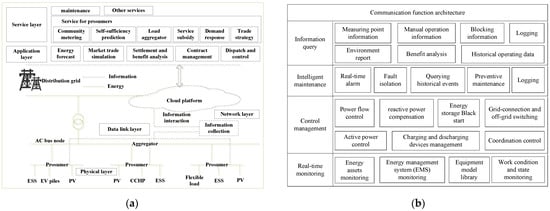
Figure 3.
The architecture figure. (a) Information interaction and prosumers’ structure; (b) Communication function architecture.
3.4. Modeling and Optimization
3.4.1. Modeling
The purpose of the optimization resolution is to get bought and sold power hourly in the day-ahead market. The objective is to minimize the economic cost F.
The equality constraint is the power balance constraint. The formulas are explained:
- (1)
- The objective function F can be positive for payout or negative for benefit. If the EV is assumed to be uncontrolled without the controlled costs, the cost F is the sum of the interruptible load cost CIL,t, transferable decreased load cost CTL-D,t, micro gas turbine’s operation cost CMT,t, energy sharing buy cost Cbuy,t, storage charge and discharge power cost CESS,t, minus the energy sharing sell cost Csell,t, minus wind power subsidy CWG,t, and minus PV subsidy CPV,t. The various costs are equal to the price pIL,t, pTL-D,t, pMT,t, pbuy,t, pESS,t, psell,t, pWG,t, pPV,t multiplied by 1 h of corresponding power;
- (2)
- The prosumers can sell excess power to the main grid at pgrid, while the other peers sell through P2P at price psell,t after self-sufficiency. If the peers are rational to maximize benefit, power will be bought from the main grid when pgrid ≤ psell,t, while P2P trade will be succeed when pgrid ≥ psell,t. Thus, ToU tariff is very important and useful information for both sides of P2P trade because it decides whether consumers buy power directly from the main grid or other peers through P2P trade [38]. Furthermore, the users also have irrational behavior, increasing the randomness of quotation. Thus, in this paper, the quoted price pbuy,t and psell,t are assumed to be uniform distribution U(a, b);
- (3)
- The CCHP provides electricity whether it provides heat or not due to its two operation modes, often combined with the electric heat pump’s heating and cooling ability. The heating and cooling can be self-balanced among a CCHP system because the heat and cool load is fixed. The electricity, heat and cooling energies are simultaneously, only electricity can be used for P2P trade considering limitations of the transmission and loss [38]. Thus, we can predict the demand for electricity, cooling and heat, but P2P only for power at present. Thus, the heat and cooling balance constraints are neglected;
- (4)
- The power balance equality constraint is the balance of output and input power, including the micro gas turbine’s active power PMT,t, wind power generation PWG,t, PV power generation PPV,t, energy sharing buy power Pbuy,t, energy sharing sell power Psell,t, interruptible load power PIL,t, transferable load decrease power PTL-D,t, transferable load increase power PTL-I,t, prosumer’s load PLoad,t, EV load PEV,t, electrochemical energy storage charge power Pcharge,t and discharge power Pdischarge,t;
- (5)
- The energy sharing buy power Pbuy,t and sell power Psell,t are limited by the line transmitted exchange power limit Pexchangelimit and energy sharing buy state kt and sell state (1-kt), kt = 0 or 1;
- (6)
- The micro gas turbine’s active power PMT,t constraint is limited by the maximum output PMTmax and minimum output PMTmin;
- (7)
- The wind PWG,t and PV PPV,t output constraint is the predicted value PWGforecast,t and PPVforecast,t considering the small positive and negative errors as ±∆ε and ±∆δ, respectively. The stochastic optimization method can model and resolve it. If ignoring the forecast errors, ∆ε≈0 and ∆δ≈0, the predicted wind and PV power are the determined values. In this paper, the prediction errors are neglected;
- (8)
- The interruptible load is limited by the maximum power limitation PILmax;
- (9)
- The transferable decrease load is limited by the peak load ceiling PTL-Dpeak, if the PLoad,t > PTL-Dpeak during the peak load periods, we transfer the excess load PTL-D,t1 to the valley load periods PTL-I,t2 from 0:00 am to 6:00 am;
- (10)
- If considering the EV uncontrolled, the EV load constraint is the predicted value PEVforecast,t with the forecast errors ±∆ϕ;
- (11)
- The Pcharge,t and Pdischarge,t are limited by the maximum charge power Pchargemax and maximum discharge power Pdischargemax, respectively;
- (12)
- For the prosumer with PV-WG-ESS, the overall output characteristic is a horizontal line after self-balancing. When it is subsidized, the cost is a constant at the maximum output.
3.4.2. Optimization Algorithm Flow Chart and Pseudo-Code
The optimization algorithm flow chart and pseudo-code is shown in Figure 4.
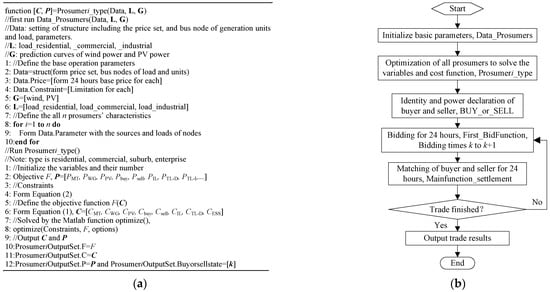
Figure 4.
The pseudo-code and the flow chart of simulation process. (a) Pseudo-code of the optimization; (b) Flow chart of the whole process.
3.5. P2P Distributed Trading Mode
In the P2P distributed continuous bilateral auction market, there are 24 time periods. The transaction involves the following three steps:
- (1)
- Step 1: To release information.
After finishing the next day’s demand forecast, the market releases the information of the seller and buyer and generates the strategy set of the seller Si and buyer Bj, respectively. At the time t, the seller i sells the power Pi,tseller at the price pi,tseller, and the buyer j buys the power Pj,tbuyer at the price pj,tbuyer.
Because the users have different internal resource and characteristics, in order to avoid being captured the characteristics of supply and demand, the user may take a P2P bidding strategy based on the multiple segment quotation mechanism. If considering the price pi,tseller unchanged, in the selling information set Si,j, the seller i splits the power Pi,tseller into multiple segments Pi,j,tseller to buyer j. This causes that under the unchanged price pj,tbuyer, in the buying information set Bi,j, the buyer j also splits the power Pj,tbuyer into multiple segments Pi,j,tbuyer.
- (2)
- Step 2: Flexible bilateral consultation and trading.
To maximize the profit, the seller gives priority to the buyer with higher price for the flexible energy negotiation. The seller seeks the following objective function.
The buyer preferentially choose the seller with lower price for the flexible energy negotiation. The objective function of the buyer seeking to match the seller is as follows.
If a bilateral transaction has no solution, the bilateral auction is terminated. The users who have already reached a negotiation publish the results {Si,j, Bi,j} as follows.
The seller trades the power Pi,j,ts-trading at the price pi,j,ts-trading, and the buyer trades the power Pi,j,tb-trading at the price pi,j,tb-trading. The Equations (14) and (15) show that the one who receives the trading information first has the priority to decide the electricity price and the trading power released to each other. The trading power can only satisfy the smaller demand. After the release of the negotiation result, the transaction contract takes effect after being signed by both parties on the cloud platform, as shown in Figure 5.
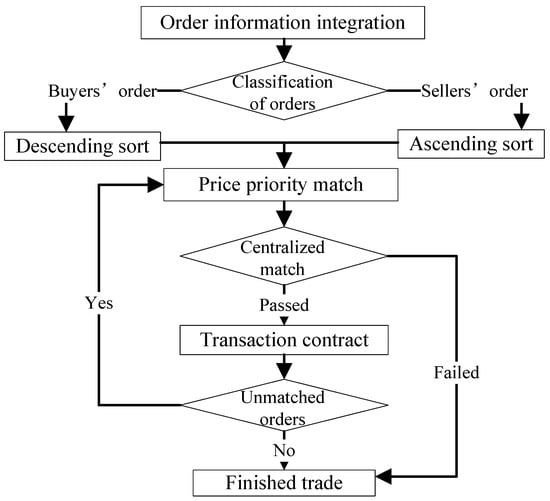
Figure 5.
The process flowchart based on the cloud platform trade.
- (3)
- Step 3: Check and adjust the settlement for the deviation power quantity and deal with the unbalanced power and unsuccessfully traded users.
In addition to forecasting demand trading for the next day, the actual trading quantity and settlement of the previous day needs to be adjusted, because there is a certain deviation between the forecast and the actual traded electricity.
After P2P distributed trade, there may be some unbalanced power of the individual users, balanced through trading with the upstream power grid. After completing step 2, the unsuccessfully traded users can report the information to the cloud platform and ask the power grid company for supplementing the unbalanced power. Those who have the surplus power can sell it to the power grid company at the on-grid price.
4. Key Technology
4.1. Construction of Monitoring System
The monitoring system is shown in Figure 6.
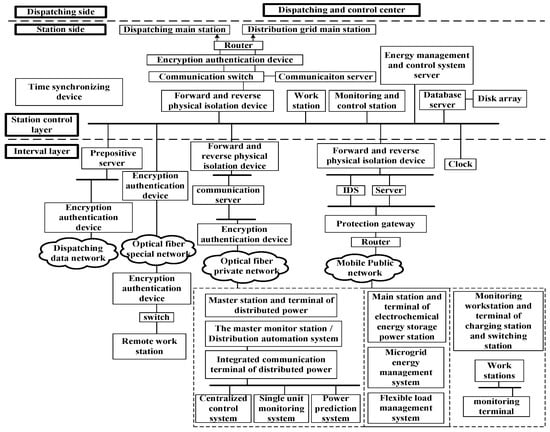
Figure 6.
The structure of monitoring system.
The monitoring system consists of two parts: station control layer and interval layer. The monitoring host collects and stores the real-time data such as the distribution grid operation, multiple energy operation and equipment condition and has four remote functions such as the remote sensing, remote communication, remote adjustment and remote control. After collecting the real-time data, the data communication network transmits the real-time data to the dispatching and control center through the platform’s information layer, carries out information interaction with the dispatching and control center, sending equipment anomaly and alarm information, and providing information query and other services.
The equipment on the station control layer consists of the monitoring host or/and monitoring workstation, other functional workstations, data communication network gateway device, integrated application server, time synchronization device and remote communication equipment, and so on.
The equipment on the interval layer includes the bus network, the measurement and control equipment connected with computer network, PMU devices, and so on.
4.2. Interaction between Cloud Platform and Other Systems
The cloud platform exchanges data with the monitoring system, the distribution automation system, the dispatching automation system, the power demand response system, the external environment platform for public service, and the external network data center. The interaction between cloud platform and other automated information systems is shown in Figure 7.
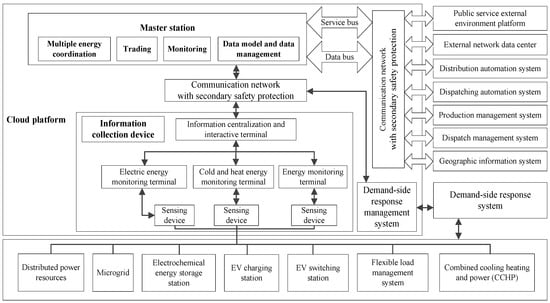
Figure 7.
The structure of interaction between the cloud platform and other information systems.
4.3. Distributed Resource Model and Interface Data Splicing of EMS
The common information model (CIM) of EMS provides a standard representing method including the object classes and their relationship. The CIM is defined by the object-oriented modeling technique. The unified modeling language notation is adopted to define the abstract models as sets of packages. Each package contains one or more class diagrams showing all the classes with their relationships. The class diagram for the distributed resource package and flexible load is shown in Figure 8 and Figure 9, respectively. The double colon represents a scope character used in class names to distinguish members of different classes with the same name. When using Unified Modeling Language (UML) to represent relationships between the classes, the asterisk represents the multiple objects. The basic CIM package adopts IEC 61970 CIM, and the distribution network extension package adopts IEC 61968 CIM. The class name of each module of the distributed resource can be extended to multiple class names, including the system parameter class, the control parameter class, the warning parameter class, and the component parameter class. The schematic diagram of grid splicing model is shown in Figure 10.
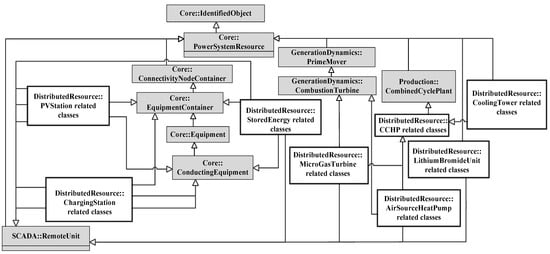
Figure 8.
The simplified schematic class diagram for the distributed resource package.
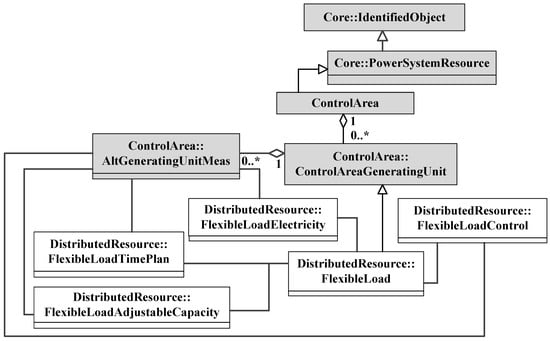
Figure 9.
The class diagram for the flexible load in the distributed resource package.
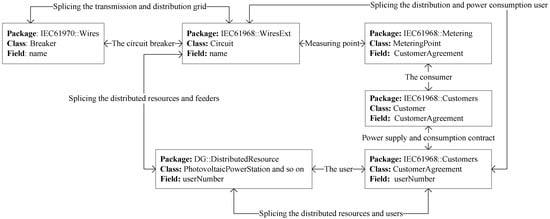
Figure 10.
The schematic diagram of grid splicing model.
5. P2P Trading Simulation Based on MATLAB
5.1. Parameter Setting
The 10 kV improved IEEE 33 node distribution system with 10 prosumers is used to simulate in Figure 11. The basic parameters of energy storage unit and micro gas turbine are shown in Table 1 and Table 2. The output of wind power and PV, the industrial, commercial and residential load can be combined by four basic clusters of per-unit value curves are shown in Figure 12 and Figure 13. The base price are shown in Figure 14 and explained in Table 3. To simulate the bidding price, the random sampling with a uniform distribution U(ɑmin,t, ɑmax,t) is adopted. The 10 prosumers is introduced in Table 4. The parameters of interruptible load, translation load and EV are in Table 5. The case is simulated in MATLAB. The program codes are attached as the supplementary materials.
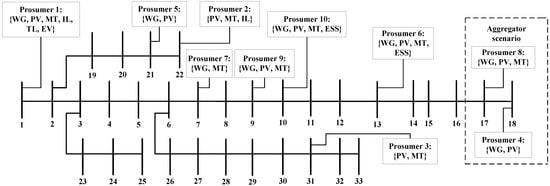
Figure 11.
Simulation model of IEEE 33-bus distribution system.

Table 1.
Basic parameters of the electrochemical energy storage.

Table 2.
Basic parameters of the micro gas turbine.

Figure 12.
The basic per-unit value curve of output prediction. (a) Wind power; (b) PV power.
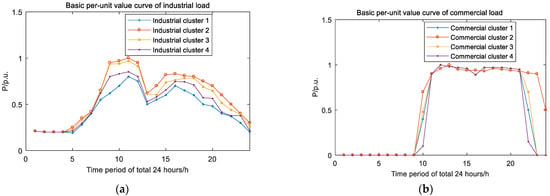
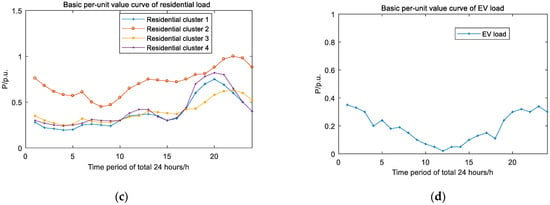
Figure 13.
The basic per-unit value curve of industrial, commercial and residential load. (a) Industrial load; (b) Commercial load; (c) Residential load; (d) EV load.
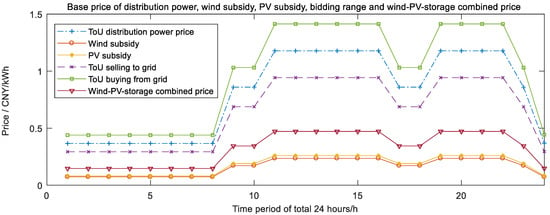
Figure 14.
The base reference price of distribution power from superior power grid, the wind subsidy, PV subsidy, base minimum and maximum price of bidding range, and wind-PV-storage combined price.

Table 3.
The basic price and bidding price setting rule.

Table 4.
The 10 prosumers’ information.

Table 5.
The parameters of the interruptible load, translation load and EV.
5.2. The Program Steps
5.2.1. The Program Steps of P2P Distributed Trade
- (1)
- Step 1: Initialization. Input the basic parameters of generation, load type, and 10 integrated energy users;
- (2)
- Step 2: The optimization solution of 10 integrated energy users. According to the basic buying price from and selling price to the superior power grid, the linear optimization problem for 10 users with the objective of minimum each user’s cost is solved under the equality constraint of power self-balance and inequality constraints of operating limitations. To find out the potential users who need to buy and sell power to the superior power grid;
- (3)
- Step 3: Bidding stage. Organize the users with generation feature to sell power, and that with load features to buy power with 24 hours’ different slightly fluctuating prices. The sellers declare the selling power and price. The buyers declare the buying power and price. The quoted price can be higher or lower than the basic exchanging price to the superior power grid, to create incentives for the integrated energy users.
- (4)
- Step 4: Finish the transaction and settlement. The successful transaction is settled according to the average price of the seller and the buyer. The failed transaction is purchased at the determined price by power grid company;
- (5)
- Step 5: Benefits analysis. To be decentralized, avoid the power grid charging an intermediate fee among these integrated energy users through the price difference.
5.2.2. Bidding Influenced by Grid’s ToU
According to the basic peak-flat-valley electricity price of power grid company, the 24 h of a day are divided into four main bidding segments, namely the valley load time period (24:00 pm–7:00 am), flat-peak-flat period (8:00 am–11:00 am), flat-peak-flat period (12:00 am–17:00 pm), and flat-valley period (18:00 pm–23:00 pm). The ToU selling to grid and ToU buying from grid constrain the bidding price within a certain range.
5.3. Simulation Results
5.3.1. The Optimized Operation Scenarios of 10 Prosumers
The optimized operation scenarios of 10 prosumers are shown in Figure 15.
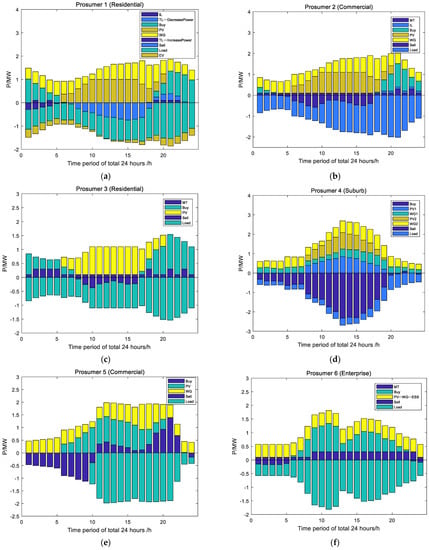
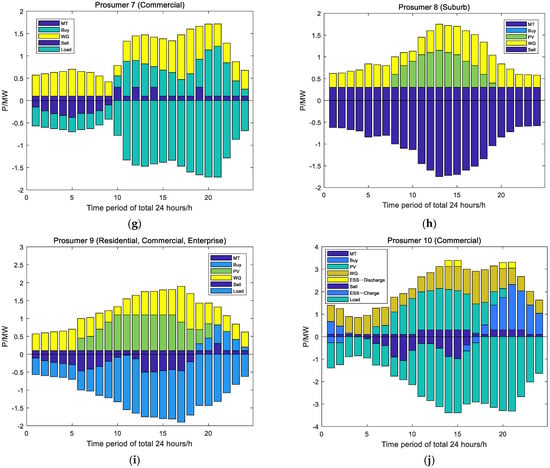
Figure 15.
The optimization operation scenarios of 10 prosumers. (a) Prosumer 1; (b) Prosumer 2; (c) Prosumer 3; (d) Prosumer 4; (e) Prosumer 5; (f) Prosumer 6; (g) Prosumer 7; (h) Prosumer 8; (i) Prosumer 9; (j) Prosumer 10.
5.3.2. P2P Distributed Trading
The random quoted price scenarios for the first stage by generation users and load users are shown in Figure 16. The cost compared with no bidding just exchanged with grid is shown in Table 6. The positive value means the cost, and the negative value means the income. The total cost of scenario 1 is balanced, less than that of scenario 2.
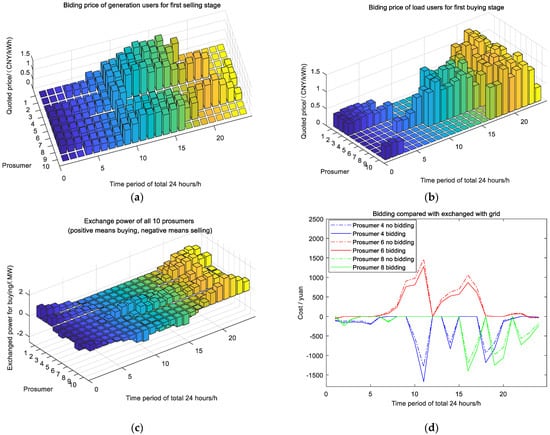
Figure 16.
The bidding scenario for the first stage of P2P distributed trading. (a) Generation users; (b) Load users; (c) Exchanged power after first matching; (d) Bidding costs compared with exchanged with grid about prosumer 4, 6 and 8.

Table 6.
The cost comparison of the successfully traded exchange power for 24 h under two scenarios.
Due to the randomness of bidding, the results of successful bids are different. The bidding result of scenario 1 in Table 6 is just one possible outcome. For the generation and load prosumers, the P2P trade is benefit for both, if compared with exchanged with grid.
5.3.3. Aggregator Scenario of Prosumer 4 and 8
To analyze the impact of aggregation degree on the cost, the prosumer 4 in node 18 and prosumer 8 in node 17 are aggregated as aggregator 4, two geographically close to each other in the suburb. The metering point for exchanged power with grid is between node 16 and 17. Take the first bidding stage at 1:00–2:00 in Table 7 and Table 8 for example. The distributed trade leads to the cost reduction compared with exchanged with grid as shown in Table 9. Take two prosumers for example in Figure 17, there is more than a 1500 yuan cost reduction for prosumer 6 and more than 2000 yuan income for aggregator 4.

Table 7.
The information releasing of all prosumers at 1:00–2:00 on the scenario of prosumer 4 and 8 as aggregator 4.

Table 8.
The matching result for the first bidding stage at 1:00–2:00 on the scenario of prosumer 4 and 8 as aggregator 4.

Table 9.
The cost comparison of the successfully traded exchange power for 24 h under two scenarios.
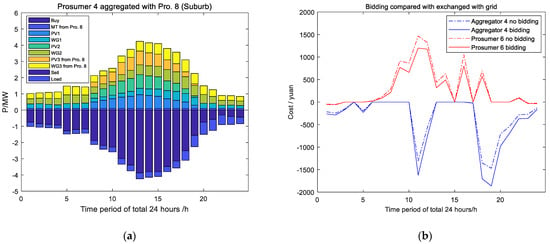
Figure 17.
The bidding scenario for the first stage on the aggregator scenario. (a) Aggregator 4’ s optimization solution; (b) Bidding compared with no bidding of user 4 and 6.
5.3.4. Bidding Strategy Analysis
The income of aggregator 4 is less than the sum of user 4 and 8, due to the trade failed when the bidding price is higher than the mean bidding price and mean capacity price pc,t of all generation users including aggregator 4 in Figure 18.
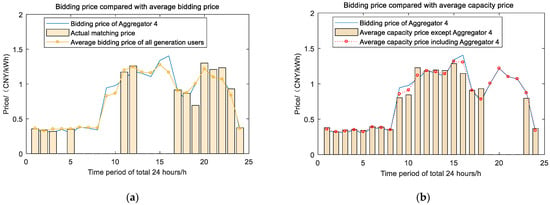
Figure 18.
The bidding price comparison. (a) Compared with average bidding price; (b) Compared with average capacity price.
In order to improve the competitiveness of pure renewable energy prosumers, it’s necessary to study the quotation strategy. Although they are the only power suppliers in the evening peak-load periods, the loss of the morning peak-load will lead to profit reduction. The pricing strategy is that the quotation of the renewable energy aggregator should be lower than the average quotation, otherwise, when the supply and demand of electricity are not absolutely dominant, the aggregator may fail trade suffering from the monopoly and high quotation price. Thus, the aggregated quotes aren’t necessarily more profitable than the decentralized quotes, ensuring the distributed trade feasible.
5.3.5. Benefit and Behavior Feasibility Analysis
After Monte Carlo simulation, the random quotation leads to very different results. There are still some general features as follows.
For the grid, the P2P trade is a completely decentralized mode, benefit for the prosumers to develop renewable energy construction. From the point of view of the power grid company, it need to take into account the cost of power flow, platform construction and operation cost, information flow cost and distribution grid usage fee. The factor affecting prosumers’ revenue is the scale and structure of the “source + load” and bidding price, not the subsidy price coefficient.
Currently, there are some supporting policy, such as the establishment of integrated energy companies and renewable energy participating in the power market, the pilot cloud platform at the prefecture-level supported by the national key project fund, and a large number of forward-looking scientific and technological projects of grid companies. The needed supported policy, the regulatory environment to collect self-consumption of prosumers, promote subsidy policies, allowing the prosumers or aggregators to participate in energy market pools for bilateral or multilateral contracts are in the transition from small proportion to reasonable increased market share. Thus, the study on the feasibility of P2P trade in China, can help to expand the share of the decentralized market.
6. Conclusions
To establish a cloud platform to gather wind power, PV, energy storage, flexible load, micro-grid, EV piles for high efficient management is current development trend. The energy interconnection and sharing platform in Dongguan was established in 2017 and put into operation in 2019. Based on cloud edge computing, it has realized the prosumers’ distributed energy resources integrated to local grid management platform. Once the market policy is released, the platform will add the market operation module. Actually, P2P trade and cloud platform management still need large amount of work to be successfully implemented in the real project. The suggestions and contributions are as follows:
- (1)
- For feasibility, although currently there are no policies or rules legally allowing P2P energy trade, it must be validated in theory and practice so that the policy makers can understand the benefits and impact of P2P trade to consider reasonable regulation. Additionally, the power market hasn’t yet real-time pricing, but the ToU price selling to and buying from grid can be used as a bidding reference. P2P trade carries uncertain risks, but as a whole, it splits the grid’s revenue among prosumers to reduce government’s pressure on subsidies. Due to the risks of P2P trade, the platform managers must have a high level of credit, and the strict supervision is necessary to ensure high levels of reliability and security;
- (2)
- For methodology, this paper presents detailed modeling, algorithm, matching rule and pseudo-code for optimization. For the case verification, this paper simulates the electricity trade scenarios among different prosumers with different characteristics of industrial, commercial and residential load, distributed generation, energy storage, and micro gas turbine of CCHP. In addition, for the relationship in the real-world, the energy market stakeholders, such as prosumers, integrated energy service company, grid company, platform manager, and regulatory are discussed for their roles in the platform;
- (3)
- For technology, the information interconnection system is built according to standard five-layer structure. The distributed resource modeling and interface data splicing of EMS are important in managing the distributed energy equipment ledger. The communication function architecture needs to achieve some basic functions, including the real-time monitoring, and control management. Other functions, such as the devices’ state assessment and the remote application based on the handhold APP, can be further developed. The construction of platform needs the comprehensive technology of the communication and information technology, software and electrical engineering to realize the development of the basic and extended functions.
Supplementary Materials
The following supporting information can be downloaded at: https://www.mdpi.com/article/10.3390/pr10112272/s1. The program codes are attached as the supplementary materials.
Author Contributions
Conceptualization, J.L., Y.X. and X.H.; methodology, J.L., Y.X., X.H. and D.Z.; software, Y.X., D.Z. and J.L.; validation, J.L. and Y.X.; formal analysis, J.L., Y.X, X.H. and D.Z.; investigation, J.L., X.H. and D.Z.; resources, Y.X. and X.H.; data curation, Y.X. and J.L.; writing—original draft preparation, J.L. and Y.X.; writing—review and editing, J.L.; supervision, J.L. and D.Z.; project administration, J.L., Y.X. and X.H.; funding acquisition, J.L. All authors have read and agreed to the published version of the manuscript.
Funding
This research was funded by the Science and Technology Project Foundation and supported by the China Southern Power Grid Company Limited (030000KK52190010 (GDKJXM20198116)).
Acknowledgments
Thanks to the researchers at the Sichuan Energy Internet Research Institute, Tsinghua University for helping to provide most of the source program. We would like to express our gratitude to them for their help and guidance.
Conflicts of Interest
The authors declare no conflict of interest.
References
- Guilhot, L. An analysis of China’s energy policy from 1981 to 2020: Transitioning towards to a diversified and low-carbon energy system. Energy Policy 2022, 162, 112806. [Google Scholar] [CrossRef]
- Bai, J.; Xin, S.; Liu, J.; Zheng, K. Roadmap of realizing the high penetration renewable energy in China. Proc. CESS 2015, 35, 3699–3705. [Google Scholar]
- Liu, J.; Zhang, N.; Kang, C.; Kirschenb, D.; Xia, Q. Cloud energy storage for residential and small commercial consumers: A business case study. Appl. Energy 2017, 188, 226–236. [Google Scholar] [CrossRef]
- Liu, J.; Zhang, N.; Kang, C. Research framework and basic models for cloud energy storage in power system. Proc. CESS 2017, 37, 3361–3371. [Google Scholar]
- Awerbuch, S.; Preston, A. The Virtual Utility: Accounting, Technology & Competitive Aspects of the Emerging Industry; Springer: New York, NY, USA, 2012. [Google Scholar]
- Bai, Y.; Huang, Y.; Chen, S.; Zhang, J.; Li, B.; Wang, F. Cloud-edge intelligence: Status quo and future prospective of edge computing approaches and applications in power system operation and control. Acta Autom. Sin. 2020, 46, 397–410. [Google Scholar]
- Jin, W. Research on Distributed Storage Convergence and Coordination Control Strategy. Master’s Thesis, China Electric Power Research Institute, Beijing, China, 2018. [Google Scholar]
- Guo, B.; Niu, M.; Lai, X.; Chen, L. Application research on large-scale battery energy storage system under Global Energy Interconnection framework. Glob. Energy Interconnect 2018, 1, 79–86. [Google Scholar]
- Feng, C.; Liao, X. An overview of “Energy+Internet” in China. J. Clean. Prod. 2020, 258, 120630. [Google Scholar] [CrossRef]
- Kirschen, D.S.; Strbac, G.; Cumperayot, P.; de Paiva, M.D. Factoring the elasticity of demand in electricity prices. IEEE Trans. Power Syst. 2020, 15, 612–617. [Google Scholar] [CrossRef]
- Wang, J.; Zhong, H.; Ma, Z.; Xia, Q.; Kang, C. Review and prospect of integrated demand response in the multi-energy system. Appl. Energy 2017, 202, 772–782. [Google Scholar] [CrossRef]
- Clegg, S.; Mancarella, P. Integrated Modeling and Assessment of the Operational Impact of Power-to-Gas (P2G) on Electrical and Gas Transmission Networks. IEEE Trans. Sustain. Energy 2015, 6, 1234–1244. [Google Scholar] [CrossRef]
- Jin, H.; Sui, J.; Xu, C.; Zheng, D.; Shi, L. Research on theory and method of multi-energy complementary distributed CCHP system. Proc. CESS 2016, 36, 3150–3160. [Google Scholar]
- Ren, G.; Yu, M.; Yin, D.; Huang, S.; Xu, H.; Yuan, M. Design and optimization of integrated energy management network system based on internet of things technology. Sustain. Comput. Inform. Syst. 2021, 30, 100502. [Google Scholar] [CrossRef]
- Xu, Y.; Zhang, J. Regional integrated energy site layout optimization based on improved artificial immune algorithm. Energies 2020, 13, 4381. [Google Scholar] [CrossRef]
- Zhou, Y.; Hu, W.; Min, Y.; Dai, Y. Integrated power and heat dispatch considering available reserve of combined heat and power units. IEEE Trans. Sustain. Energy 2019, 10, 1300–1310. [Google Scholar] [CrossRef]
- Hemmati, M.; Abapour, M.; Mohammadi-lvatloo, B.; Anvari-Moghaddam, A. Optimal operation of integrated electrical and natural gas networks with a focus on distributed energy hub systems. Sustainability 2020, 12, 8320. [Google Scholar] [CrossRef]
- Li, G.; Zhang, R.; Jiang, T.; Chen, H.; Bai, L.; Cui, H.; Li, X. Optimal dispatch strategy for integrated energy systems with CCHP and wind power. Appl. Energy 2017, 192, 408–419. [Google Scholar] [CrossRef]
- Jiang, P.; Dong, J.; Huang, H. Optimal integrated demand response scheduling in regional integrated energy system with concentrating solar power. Appl. Therm. Eng. 2020, 166, 114754. [Google Scholar] [CrossRef]
- Lei, Y.; Hou, K.; Wang, Y.; Jia, H.; Zhang, P.; Mu, Y.; Jin, X.; Sui, B. A new reliability assessment approach for integrated energy systems: Using hierarchical decoupling optimization framework and impact-increment based state enumeration method. Appl. Energy 2018, 210, 1237–1250. [Google Scholar] [CrossRef]
- Shao, C.; Shahidehpour, M.; Wang, X.; Wang, X.; Wang, B. Integrated planning of electricity and natural gas transportation systems for enhancing the power grid resilience. IEEE Trans. Power Syst. 2017, 32, 4418–4429. [Google Scholar] [CrossRef]
- Huang, W.; Zhang, N.; Yang, J.; Wang, Y.; Kang, C. Optimal configuration planning of multi-energy systems considering distributed renewable energy. IEEE Trans. Smart Grid 2017, 10, 1452–1464. [Google Scholar] [CrossRef]
- Li, J.; Xing, Y.; Zhang, D. Planning method and principles of the cloud energy storage applied in the power grid based on charging and discharging load model for distributed energy storage devices. Processes 2022, 10, 194. [Google Scholar] [CrossRef]
- Tapscott, D.; Tapscott, A. Blockchain Revolution; Tap Publications Inc.: New York, NY, USA, 2016. [Google Scholar]
- Di Silvestre, M.L.; Gallo, P.; Guerrero, J.M.; Musca, R.; Sanseverino, E.R.; Sciumè, G.; Vásquez, J.C.; Zizzo, G. Blockchain for power systems: Current trends and future applications. Renew. Sustain. Energy Rev. 2020, 119, 109585. [Google Scholar] [CrossRef]
- Nakamoto, S. Bitcoin: A Peer-to-Peer Electronic Cash System. Consulted. 2009, pp. 1–9. Available online: https://www.bitcoin.org; http://www.spacepirates.com/bitcoin.pdf (accessed on 30 March 2009).
- Ferrag, M.A.; Derdour, M.; Mukherjee, M.; Derhab, A.; Maglaras, L.; Janicke, H. Blockchain Technologies for the Internet of Things: Research Issues and Challenges. IEEE Internet Things J. 2019, 6, 2188–2204. [Google Scholar] [CrossRef]
- Yang, D.; Zhao, X.; Xu, Z.; Li, Y.; Li, Q. Developing Status and Prospect Analysis of Blockchain in Energy Internet. Proc. CSEE 2017, 37, 3664–3671. [Google Scholar]
- Wang, S.; Guo, C.; Feng, B.; Zhang, H.; Du, Z. Application of blockchain technology in power systems: Prospects and ideas. Autom. Electr. Power Syst. 2020, 44, 10–24. [Google Scholar]
- Yuan, Y.; Wang, F. Blockchain: The state of the art and future trends. Acta Autom. Sin. 2016, 42, 481–494. [Google Scholar]
- Dong, Z.; Luo, F.; Liang, G. Blockchain: A secure, decentralized, trusted cyber infrastructure solution for future energy systems. J. Mod. Power Syst. Clean Energy 2018, 6, 958–967. [Google Scholar] [CrossRef]
- Cui, J.; Wang, S.; Xin, Y. Research on technical framework of smart grid data management from consortium blockchain perspective. Proc. CSEE 2020, 40, 836–848. [Google Scholar]
- Wang, B.; Li, Y.; Zhao, S.; Chen, H.; Jin, Y.; Ding, Y. Key technologies on blockchain based distributed energy transaction. Autom. Electr. Power Syst. 2019, 43, 53–64. [Google Scholar]
- Qi, B.; Xia, Y.; Li, B.; Li, D.; Zhang, Y.; Xi, P. Photovoltaic trading mechanism design based on blockchain-based incentive mechanism. Autom. Electr. Power Syst. 2019, 43, 132–139. [Google Scholar]
- Soto, E.A.; Bosman, L.B.; Wollega, E.; Leon-Salas, W.D. Peer-to-peer energy trading: A review of the literature. Appl. Energy 2021, 283, 116268. [Google Scholar] [CrossRef]
- Castellini, M.; Corato, D.L.; Moretto, M.; Vergalli, S. Energy exchange among heterogeneous prosumers under price uncertainty. Energy Econ. 2021, 104, 105647. [Google Scholar] [CrossRef]
- Liu, J.; Zou, D.; Chen, Y.; Chu, Z.; Zuo, G.; Teng, Z. Discussions on operation mechanism and benefits of customer-side distributed energy storage P2P sharing mode of “Internet +”. Power Syst. Clean Energy 2020, 36, 97–105. [Google Scholar]
- Zhang, H.; Zhang, S.; Hu, X.; Cheng, H.; Gu, Q.; Du, M. Parametric optimization-based peer-to-peer energy trading among commercial buildings considering multiple energy conversion. Appl. Energy 2022, 306, 118040. [Google Scholar] [CrossRef]
- Si, Y.; Tan, Y.; Wang, F.; Kang, W.; Liu, S. Cloud-edge collaborative structure model for power Internet of Things. Proc. CSEE 2020, 40, 7973–7979. [Google Scholar]
- Liu, Y.; Gao, S.; Wei, X.; Huang, T.; Zang, T.; Chen, K. Research on trading model of prosumers considering the social behaviors in the power Internet of Things. Proc. CSEE 2021, 41, 3173–3186. [Google Scholar]
Publisher’s Note: MDPI stays neutral with regard to jurisdictional claims in published maps and institutional affiliations. |
© 2022 by the authors. Licensee MDPI, Basel, Switzerland. This article is an open access article distributed under the terms and conditions of the Creative Commons Attribution (CC BY) license (https://creativecommons.org/licenses/by/4.0/).